FAQs About
Soft/Shell Rot, Conditions In Turtles 12
Related Articles:
Shell Rot in Turtles, Treating Common Illnesses of
the Red Ear Slider (& other Emydid Turtles) by Darrel
Barton, The
Care and Keeping of the Red Eared Slider, Trachemys scripta elegans by
Darrel Barton,
Red Ear Sliders, Turtles, Amphibians, Red
Eared Slider Care,
Related FAQs: Shell Rot 1, Shell Rot 2, Shell Rot 3, Shell Rot, Conditions 4, Shell Conditions 5, Shell Conditions 6, Shell Conditions 7, Shell Conditions 8, Shell Conditions 9, Shell Conditions 10, Shell Conditions 11, Shell Conditions 13,
Shell
Conditions 14, Shell Conditions
15, Shell Conditions 16,
Shell Conditions 17,
& Turtles, Turtles
2, Turtle Identification,
Turtle Behavior, Turtle Compatibility, Turtle Selection, Turtle Systems, Turtle Feeding, Turtle Disease, Turtle Disease 2, Turtle Disease 3, Turtle Reproduction, Amphibians, Other
Reptiles,
|
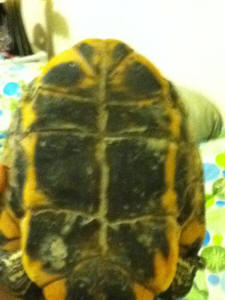
|
|
Baby RES Turtles, shell colour concern
7/20/11
Hi WWM Crew,
<Hi, Norma, Sue here with you.>
I have 2 RES turtles I purchased for my kids from someone on the
beach about 4 months ago without knowing just how much of a pain
in the butt it would be to set up the proper semi-aquatic habitat
for them, money wise that is.
<Well, good for you that you at least committed to getting
them what they needed after you found out!>
So I've searched the web and slowly purchased almost
everything I need for them to be in a healthy and happy home,
including a heat/uvb lamp and basking area. Do you think I should
get a red light for at night?
<No light needed at all at night; the dark is just fine! A
night time heat lamp (red, black or any other color for that
matter) may be helpful for other types of reptiles, but it's
not necessary for aquatic turtles. The heat lamp is intended for
their daytime, placed directly above their basking spot so that
it heats them up while they're out of the water basking
(basking temperature should be in the 88-90 degree range).
>
I have noticed their shells are changing colors and I think they
are shedding their shells because I do notice they have gotten
bigger over the last few months. My problem is that I just
can't tell if that's what it is. They eat lettuce
occasionally, but mostly they like Zoo Med Aquatic Turtle food
(micro sized pellets) which I've been feeding them 2-3 times
a day because they are babies.
<Nope; the shell shedding has nothing to do with not giving
them a night time heat light. The 2-3 times a day feedings is the
reason they're shedding; the shedding is just an
'outgrowth' of them 'growing' '¦
sorry, couldn't resist that bad pun!>
<Turtles do grow fastest when they're little like that,
but you do want to prevent excessively fast growth as that can
lead to shell deformities and other health problems. Contrary to
what you might read on 'other' websites about how often
to feed baby turtles, unless they're literally brand new
hatchlings, you should only be feeding them one time, only every
other day, and no more than they can eat in 5-10 minutes,
especially when the protein content is a higher percentage as it
is with the Zoo Med micro pellets. Over-feeding is one of the
most common mistakes people make with turtles. I'd also
switch them to the growth formula. Just soften the pellets in
water first to make it easier for them to nibble at it.
Alternatively you can give them ReptoMin sticks which most
turtles seem to love, or Koi pellets (KayTee brand even makes a
mini Koi pellet).>
<Another thing that can contribute to a faster growth rate is
when their water is kept too warm. Again, contrary to what you
may read on most other websites, even when they're small,
their water temperature should still be kept in the cooler range,
around 70 degrees F.>
I had them in a 20 gal. tank until about 3wks ago when I moved to
N.Y. from Cali. where I accidently left the tank. So I set them
up in a plastic drawer about 5 or so gallons deep with a filter,
rocks, a fake log for basking and a 75watt uvb light. They bask
ALL the time and always eat.
<I can tell you've done your research and everything
sounds great except the 'always eating' part! Though the
fact that they have a good appetite IS great, and a sign that
they're healthy!>
I have enclosed some pictures of them. I also haven't seen
any shell pieces falling off, just a lot of discoloration.
<By discoloration, do you mean the new growth that is coming
in is a lighter green? If so, that's a perfectly normal
color. Also, while they're still in the shedding process, you
may notice that their shells temporarily appear a bit duller in
color until they're all done shedding, and the new shell
underneath is completely exposed. As long as the newer shell
that's coming in looks fine, then this is all normal.>
I'm so confused, I know they can live more than 30 yrs and I
really like that idea and we love the lil buggers
<They are pretty irresistible, aren't they?!>
so any help and/or advice would make my day!
<The main items are a good diet, don't overfeed, cool
clean water and warm, dry basking spot with UVB; most of which
you already have covered!>
<If there's one additional pointer I could offer you, it
would be re: the water quality. You mentioned you have a filter
which is great. Just don't let that lull you into a false
sense of security. You'll still need to do frequent water
changes even with a good quality filter, especially as they start
to grow bigger. Also try to net up any debris you see right away;
don't allow it to collect between water changes. Here is a
link below to a good article on our website about general care.
It sounds like you've got most of the basics covered, but
look this over to see if there is anything else you might need to
tweak:
http://www.wetwebmedia.com/FWSubWebIndex/RESCareBarton.htm
>
Thank you ~Norma
<You're welcome, Norma! Good luck with them. Let me know
if there's something I missed in the photos regarding your
concern over the discoloration.>
|
|
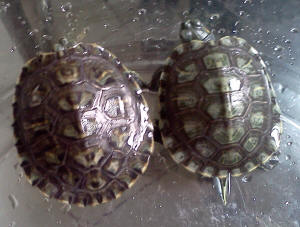
|
|
Re: re: Baby RES Turtles
7/23/11
Thank you Sue for the quick response.
<You're welcome, Norma.>
The link to the article you suggested was really awesome and
helped put my mind at ease as far as their habitat I have set up
for them.
<Yes, it can be pretty overwhelming when you start out,
especially with all the information that's out there, and
when so much of it is contradictory!>
After reading the article, (I really wish I found WWM when I
first got my turtles) I decided their water needed changing. I
usually set the new water up a little on the cool side of warm
(if that makes any sense). I don't have a thermometer so I
use my wrist to check the temp. Also their basking area is a log
they can go under to get in the shade.
<If the log is hollow, keep an eye on this and any other decor
that they could potentially become trapped in or under,
especially as they start to grow. Turtles can actually drown if
they land up getting trapped under water!>
I think I will get a thermo. to be sure it's not too warm
anyways.
<It's really not a bad idea. Most sell for under $10. I
actually use 2 -- one in the water and one under the heat and UVB
lamps. >
<In particular, with smaller enclosures like the one you have,
temperatures, especially water temperatures, can often fluctuate
several degrees during the day even if the air temperature in
your room is kept in the 68-70 degree range. Heat lamps heat up
not only the land inside the enclosure, but can also heat up the
water several degrees throughout the day. Even filters can make
water temperatures rise a couple of degrees. The less water (and
the less deep the water) is in your set-up, the more it will be
susceptible to temperature fluctuations. The temperature above
the basking area will also continue to rise throughout the day,
though it's usually more stable and predictable than the
water temperature.>
So as I changed the water I let the turtles just dry off for a
while in the sun and I saw one of their shell parts (forgetting
the name) peeling up a little! So I'm definitely sure
it's shedding that I see now.
<Yes, and I realized I never mentioned this in my first email.
The more 'normal' the shedding is, the less noticeable
the peeling layers will be. They should be paper thin. And you
often don't notice it as much until you take them out of the
water. From what you've described, though in this and your
other email, it's more than likely the shedding with your
turtles is just normal shedding. And you'll always notice
their shells dulling in color while it's happening. >
<Having said that, there's also a fine line between fast
but normal growth and normal shedding; and growing too fast and
excessive shedding. And usually shedding does start out normal
before it becomes abnormal. That's why I wanted to alert you
about cutting back on the feedings and keeping the water clean
and on the cooler side before it does become abnormal!>
Yes, their shells were getting lighter spots all over and their
designs are harder to see because of dulling.
<As above, this is normal.>
How long will it take to shed completely I wonder now?
<Usually several weeks, but certain factors can influence it
like a turtle's age, their individual growth rate,
environmental conditions, etc.>
As far as the feeding, omg thank you! I didn't even realize I
was doing something wrong. I'm so happy I found out I was
over feeding them and now I know what else is good for them to
eat.
<It's a very common mistake people make so don't
worry. And the important thing is you found out before any ill
effects.>
We want happy and healthy turtles :-)
<It sounds like you do so far!>
Your web site is the bomb! It has sooooo much good information.
Thank you Sue and WWM for helping! Have a great day! Turtle
love!!
<Thanks, Norma! It makes us happy when we know we've
helped. Don't hesitate to write again if you have any more
questions or concerns. We want you to have happy and healthy
turtles, too! - Sue>
~Norma
Re: re: Baby RES Turtles
7/23/11
Thank you Sue for the quick response.
<You're welcome, Norma.>
The link to the article you suggested was really awesome and
helped put my mind at ease as far as their habitat I have set up
for them.
<Yes, it can be pretty overwhelming when you start out,
especially with all the information that's out there, and
when so much of it is contradictory!>
After reading the article, (I really wish I found WWM when I
first got my turtles) I decided their water needed changing. I
usually set the new water up a little on the cool side of warm
(if that makes any sense). I don't have a thermometer so I
use my wrist to check the temp. Also their basking area is a log
they can go under to get in the shade.
<If the log is hollow, keep an eye on this and any other decor
that they could potentially become trapped in or under,
especially as they start to grow. Turtles can actually drown if
they land up getting trapped under water!>
I think I will get a thermo. to be sure it's not too warm
anyways.
<It's really not a bad idea. Most sell for under $10. I
actually use 2 -- one in the water and one under the heat and UVB
lamps. >
<In particular, with smaller enclosures like the one you have,
temperatures, especially water temperatures, can often fluctuate
several degrees during the day even if the air temperature in
your room is kept in the 68-70 degree range. Heat lamps heat up
not only the land inside the enclosure, but can also heat up the
water several degrees throughout the day. Even filters can make
water temperatures rise a couple of degrees. The less water (and
the less deep the water) is in your set-up, the more it will be
susceptible to temperature fluctuations. The temperature above
the basking area will also continue to rise throughout the day,
though it's usually more stable and predictable than the
water temperature.>
So as I changed the water I let the turtles just dry off for a
while in the sun and I saw one of their shell parts (forgetting
the name) peeling up a little! So I'm definitely sure
it's shedding that I see now.
<Yes, and I realized I never mentioned this in my first email.
The more 'normal' the shedding is, the less noticeable
the peeling layers will be. They should be paper thin. And you
often don't notice it as much until you take them out of the
water. From what you've described, though in this and your
other email, it's more than likely the shedding with your
turtles is just normal shedding. And you'll always notice
their shells dulling in color while it's happening. >
<Having said that, there's also a fine line between fast
but normal growth and normal shedding; and growing too fast and
excessive shedding. And usually shedding does start out normal
before it becomes abnormal. That's why I wanted to alert you
about cutting back on the feedings and keeping the water clean
and on the cooler side before it does become abnormal!>
Yes, their shells were getting lighter spots all over and their
designs are harder to see because of dulling.
<As above, this is normal.>
How long will it take to shed completely I wonder now?
<Usually several weeks, but certain factors can influence it
like a turtle's age, their individual growth rate,
environmental conditions, etc.>
As far as the feeding, omg thank you! I didn't even realize I
was doing something wrong. I'm so happy I found out I was
over feeding them and now I know what else is good for them to
eat.
<It's a very common mistake people make so don't
worry. And the important thing is you found out before any ill
effects.>
We want happy and healthy turtles :-)
<It sounds like you do so far!>
Your web site is the bomb! It has sooooo much good information.
Thank you Sue and WWM for helping! Have a great day! Turtle
love!!
<Thanks, Norma! It makes us happy when we know we've
helped. Don't hesitate to write again if you have any more
questions or concerns. We want you to have happy and healthy
turtles, too! - Sue>
~Norma
|
Indian flap shelled turtle shell problem
7/9/11
Hi,
<Hello,>
Please help me! My Indian flap shelled turtle
<Lissemys punctata.>
have white spots on his shell & that spots are growing.
<Pale markings on the shell are normal. Use Google Images to see
photos of Lissemys punctata. Shell Rot and Shell
Fungus have "foul" or "mouldy" smells that usually
make them easy to diagnose.
http://www.wetwebmedia.com/fwsubwebindex/turtshellrot.htm
A healthy turtle should have a shell with no real smell at all, beyond
that of the water it is swimming in.>
His behavior & diet are normal.
<Do make sure you are providing an adequate diet (green foods as
well as meaty foods; no live fish!) and also providing a source of UV-B
for several hours per day (either a UV-B basking lamp or 2-3 hours of
direct sunlight, not through glass!).>
Give me replay early as possible...PLEASE...'¦..
<Read:
http://www.wetwebmedia.com/fwsubwebindex/redearsliders.htm
http://www.wetwebmedia.com/fwsubwebindex/RESCareBarton.htm
Adult size is quite large, 25 cm or so, and as such, these animals to
need a big vivarium, a large rock under a heat (and UV-B) lamp for
basking, and a filter to keep the water clean. Water changes need to be
regular, 50% or more every few days. Cheers, Neale.>
|
I hope you are still answering
questions :) 7/2/11
Hi,
<Hiya - Darrel here>
I'm not sure if you guys still answer questions on your
website since the latest one was from 2010
<We answer questions every day '¦ so maybe the
topic you searched for was a bit stale>
-- but I'm desperate enough to try anyway.
<Desperate for an answer '¦ and you got me
'¦ talk about ironic>
About a year and a half ago my fiancée and I rescued
a red eared slider from a friend of ours who
(with the best intentions) bought a baby slider and had no idea
whatsoever about caring for them.
<I hate when people do that>
She had him in her 10 gallon fish tank with no basking platform,
no heat lamp, and no UVA or UVB light. She had
had him for about 6 to 7 months and he was still the size of a
half dollar and his shell was soft and gray. He had gone into
hibernation and very rarely moved.
<What he was going into was death, not hibernation>
We took him home and set him up in his own tank with a platform
and lamps and he grew amazingly fast.
<Thank you!!>
Now his shell is about 5 to 6 inches from head to tail and
developed into a healthy dark green with yellow and light green
between the scutes, although it has always been a bit
deformed from the months of living in the fish tank.
<Still -- WAY better than dead>
However, in the last month we have noticed that he had developed
odd white spots in his shell. They are not fuzzy or slimy, nor
are they secreting puss of any kind. They look very dry and
brittle. We bought high calcium food sticks to supplement his
diet (we normally feed him ReptoMin floating food sticks,
<A perfectly balanced whole diet>
crickets, mealworms,
<Too high in fat and low in nutritional value>
and rosy feeder fish).
<Perfect transport device for parasites. Stop the last two
immediately, please>
We also added a calcium block to the water.
<In order for him to get enough calcium via drinking water,
you'd have to encase him in a soup about as thick as drywall.
Forget the block. If he needs more calcium, grind up & dust
small pieces of beef or chicken liver with ordinary calcium tabs
from your local pharmacy or health food store>
About a week ago, we noticed that the white spots on his shell
were getting worse, not better. His scutes have started falling
off, but it doesn't look at all like natural, normal shedding
for growth. Wherever the scutes fall off, the shell seems almost
to have a deep gouge and a white spot develops. The scutes are
falling off, but there is no new shell growth underneath. The
white spots almost look like they could be bone, but he
doesn't act any differently.
<Yes, the scutes are dying and the remainder is scarred
bone-like tissue.>
He still eats and begs for food (if anything he eats more), he
still swims all the time, and he still basks regularly. I am very
worried about his shell though.
<He needs a veterinarian>
Also, the skin on his neck and forelegs closest to his shell has
become very light. It has always been a lighter shade of green
than his head, but now it is almost white, and it is a sickly
color. We were told that he probably has shell rot, but it seems
pretty serious and I don't know what to do. If it is shell
rot, I don't know how to treat it, and if it's not shell
rot I have no clue what else it could be. Please help me and let
me know what I need to do.
<Here is a link to basic treatment. If you read the ENTIRE
article and follow ALL the instructions (which involves keeping
him warm and dry for a few weeks) you can relieve the symptoms.
Ultimately though, the typical cause of scute loss is systemic
and we can't treat it from the outside.>
As far as I know there are no vets in my area that treat or see
reptiles other than iguanas.
< A veterinarian that can treat iguanas can treat a Red Eared
Slider. Ask your Vet for calcium and vitamin injection and a 4
week course of oral Baytril. Dosages are available online>
I am at a loss. The pictures attached are not the best, but he is
not a very social guy.
<Neither am I - and I've had a much easier life than he
has>
He loves when I feed him sticks, that's as far as his
interaction goes. He refuses to be held.
<I'm not crazy about being picked up & held,
either>
:) Thank you for your time and consideration.
<No problem - it's what we're here for. That and the
free food!!>
<read this completely:
http://www.wetwebmedia.com/FWSubWebIndex/treating%20RES%20Dis%20DarrelB.htm
>
|
|
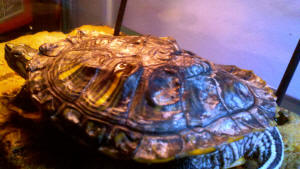 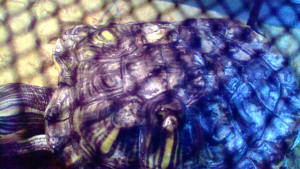
|
|
re: I hope you are still answering
questions, chel. 7/3/2011
Thank you so much for the help and advice.
<No Charge!>
I very much appreciate it. Is there anything that I can or should
add to his diet to supplement the food sticks or just vary it up
for him since removing the crickets, mealworms, and rosy
feeders?
<I raise my hatchlings all the way to adult breeders on a
basic diet of Koi pellets (same ingredients as the food sticks -
just less expensive) and an occasional (once a month) earth worm.
I go to the local pet store and buy a dozen night crawlers. If
there are any left over I dump them in the garden where they
aerate the soil.>
http://www.wetwebmedia.com/FWSubWebIndex/RESCareBarton.htm
Thanks again!
<yer welcome>
|
white spots on shell 6/3/11
Dear Crew
<Hiya! Darrel here>
My son recently found a water turtle of some kind. About 2 inches in
diameter, what I've heard called a "soft shell
turtle"
<Doe it look like this? http://www.turtlesite.info/pictures/glfs_amph_sstu.jpg
because that's a softshell turtle>
He has them in an aquarium in his room.
A few weeks ago we noticed the turtle had a white spot on it's
shell. The spot seems to be growing and now there are other tiny white
spots. Could this be a fungus?
<Undoubtedly, but without knowing the turtle specifically, I can
only give you general information.>
<First, read this from beginning to end:
http://www.wetwebmedia.com/FWSubWebIndex/treating%20RES%20Dis%20DarrelB.htm
fungus and treatment are essentially the same for the Softshells,
except that they do need a tiny bit more water during
treatment'¦ say, an HOUR a day rather than 15
minutes.>
<They also need basking time and a UV lamp. The main thing about the
softshell turtles is that they need better than average '¦
meaning EXCELLENT water quality>
<Please do some research on the internet regarding types of turtles,
take some pictures of your son's new friend '¦ and write
back. Then we'll talk>
Red Eared Slider Soft Shell 4/30/11
Dear Crew
<Hiya - Darrel here>
We have two Sliders and one has soft shell. We already know it is due
to the lack of calcium.
<Oh? How do we know this? Does that one eat a different diet? Or a
lot LESS than the other? Does that one bask under a different UV bulb?
Or bask a lot less often?>
<I'm not saying that I have that answer from all the way up here
in the cheap seats, but part of the process of investigating any
anomaly is making sure we've asked all the questions>
We had a vet come over and look at them and at our tank setup etc. Only
concern I am having is the soft shell on the bigger one.
<And the cause of the soft shell>
WE bought REP-Cal calcium w/D3.
<A fine, high quality supplement and a great one to use on an animal
that isn't feeding as well or basking as often as the rest ---
otherwise we also need to find the root cause.>
<Seeing a theme here? TREATING the soft shell is priority #1 but if
we don't find the CAUSE of it, then we don't know what
we're doing, see?>
<Let me answer another way. I have no problem with vitamin &
calcium supplements. But if the diet is healthy and right and the
lighting is healthy and right and the environment is healthy and right
- then the turtles are getting everything they need naturally
'¦ and don't need the supplements! Metaphorically you
can bail water out of a leaking boat and stay afloat forever
'¦ but you still have a hole with a hole in it. If you fix
the hole, no need to bail>
We will be buying the other with all the vitamins. My question is can a
shell conditioner help with the soft shell issue too?
<Well '¦ in a word. NO>
<In MULTIPLE words '¦ what the turtle needs is calcium,
Vitamins A&D and SUNSHINE!! UV-B if the bulb is fairly new (they
stop giving off useful UV long before they stop producing light - most
are around 10,000 hours or so (maybe 18 months to 2 years?). Also, if
the bulb is more than 10 inches from the shell or filtered through ANY
kind of screen or glass - then the UV is not getting to the
turtles>
My brother has box turtles and uses that on his and suggested we try
that on ours too. <Interesting. Box Turtles (Terrapenes) don't
get soft shell the way the hard shelled water turtles do. So we'd
be talking apples and oranges>
Thank You
<Yer welcome!>
<>
Life is to short not to go out and do something crazily insane from
time to time!
<Um '¦ I've been married, had two kids, owned my own
business, divorced and bought 5,000 shares of AMR stock. I think
I'd done my part!>
RES Inquiry 04/21/11
Hi,
<Am replying here swiftly as we need to delete your
images... too large.
Read here: http://wetwebmedia.com/FWSubWebIndex/turtshellrot.htm
and the linked Shell Condition FAQs above. Bob Fenner>
I have a few questions about the shell of one of my turtles. I
don't know how old it is but I've had it for around four months
now and it's about 6.5cm long from head to tail. I've attached
two pictures of the same turtle, both taken when I first got it and
recently. The black lines between the shell plates have thickened, and
I've noticed white-gray bits along the spine of the shell, and
I'd like to know if this is normal? I just want to check in case
I'm worrying over nothing, but better safe than sorry.
Thanks
Chloe
|
Gold Leaf on shell of Southern Painted
3/16/11
Dear Crew,
<Hiya - Darrel here>
I adopted a Baby Southern Painted Turtle a year ago. She has been
living in a 55g with water temps at 78 and basking spot at 90.
She has no problem eating a good well balanced diet, basks
regularly and is active.
<all good news>
Little gal had what looked like gold leaf on her shell. When she
sheds the spots go away but return every time. The spots are not
soft do not smell and will not come off by rubbing or scraping,
(must be deeper).
<It looks from here that it might be a fungal infection in the
carapace.
Remember that the scutes are very much like fingernail material -
the part you can actually touch is already more or less dead and
is on top of the growing material.>
<Your course of treatment is a topical anti-fungal. I'd
use a cream that you get in the store for athlete's foot
(Lamisil, Tinactin, Lotrimin, etc.)
Take her out and let the shell dry off, apply a small amount of
cream over the affected area and allow her to stay dry for 30
minutes. This is effective at any time, but just before and
immediately after a shed will be most helpful. Repeat this for 6
weeks or so and you'll get an indication if it's
improving>
Pics are of her when we brought her home, and today (exactly a
year later).
Also we have a Texas Map that we got at same time lives in same
conditions and is doing great with no problems.
Thank you so much.
<yer welcome>
Josh
|
|
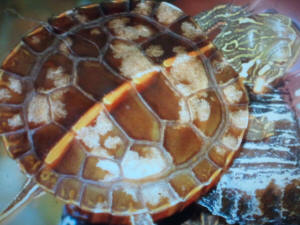 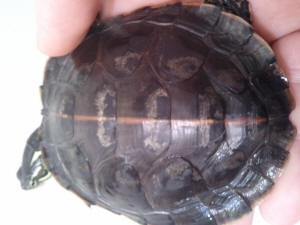
|
|
Re: Gold Leaf on shell of Southern Painted
3/21/11
Dear Darrel
<Hey there, Josh>
Thank you so much again for help, it was the first straight
answer I got from anyone, will start right away.
<As long as you keep in mind that "straight" answer
and "right" answer are not always the same
'¦>
I also just wanted to let you know that I love reading your help
responses on the site '¦
<'¦ No accounting for taste '¦.>
'¦ even when the topic is not an issue I am dealing
with. Very funny stuff.
<I'm often told that I'm "funny" but rarely
in the 'ha-ha' way ... so thanks!>
A few times I had to have the wife pause the TV so I could share
with her a witty comment. So thank you for taking the time to
educate, help, and Entertain us out here on the world wide
webz.
<We're here all week to entertain you & two shows on
Sunday '¦ please don't forget to tip your
waitress!>
-Josh.
|
|
A red eared slider question, shell bits loss
3/16/11
Dear Crew,
<Hiya - Darrel here>
I would like to thank you so much for providing a place to ask
questions. Many of the forums are just regular people guessing at
the problem and after reading your site for hours on end I see
that is definitely not the case,
<Correct. There are no regular people here. Actually we're
fairly IRREGULAR people. In fact, from Bob Fenner on down, the
only time you'll hear the word 'normal' is usually
preceded by the phrase "Substantial deviation from
'¦">
<<[Oh dear, it's going to be only of "those"
days - Editor]>><<< Hey! Darrel! You're
editing yourself! RMF>>>
you people know what you're talking about.
<well, I wouldn't go quite THAT far '¦.>
Therefore I am really hoping you will be able to help me and my
darling Ralphie. We believe that Ralphie is a female red eared
slider. She (?) came to us from a girl who was trying to see just
how big she could get a turtle to grow if she kept it on Zoo Med
growth formula all of its life.
<Bad, but I understand the premise. I once tried to see how
drunk I could get by drinking Bourbon for 3 meals a day for a
week. THAT led to the unfortunate incident with my college
roommate's girlfriend and that plate of spaghetti. But that
was a long time ago and I'm feeling MUCH better now>
<<[sigh -- I'm not gonna ask, I'm not gonna ask,
I'm not gonna ask - Ed]>><<<Note, this is
STILL Darrel!>>>
(I wish that was a bad joke but sadly it isn't) I don't
know if that is bad for a turtle (or if the food even made a
difference)
<It does, but usually it causes obesity, like my
brother-in-law, not simply accelerated growth. On the other hand,
accelerated growth (higher temps, etc) REQUIRES a growth-based,
diet - so by the looks of Ralphie (big yet fit) I'd say you
dodged whatever bullet might have been there>
but as you can see Ralphie is a big girl. Since she has lived
with us (about 4 years now) she has been on a diet of Zoo Med
aquatic turtle maintenance formula, dandelion greens, dried corn,
peas, strawberries, apples and cranberries. Every couple of weeks
we will give her some freeze dried crickets, bloodworm and river
shrimp as a treat because even though we know she doesn't
need the meat anymore she really seems to enjoy it.
<I feed mine a basic diet of Koi pellets. They're
vegetable-based with a good mix of just about all the stuff
you're feeding Ralphie. Then, for the treat, I give them and
earthworm or two every month>
Normally we feed her every other day and she eats like she is
starving.
<For an adult - three times a week, max. And I mean
"max" as in "maximum" not someone NAMED
"Max">
Lately however we have noticed that she isn't finishing her
food. I am scooping most of it out and that is not her normal
behavior. She also didn't slide back into the water when I
went to take the pictures and she allowed me to touch her shell
which is unheard of (she bites me when I take her out to clean
the tank)
<I hear you - my teenaged son has the same disposition>
but she is still swimming in the water. This past weekend we had
to go out of town for a funeral and our pet sitter came to feed
her Sunday morning. When she arrived she noticed large pieces of
shell on the bottom of the tank and she was nice enough to scoop
them out and save them for me.
<Yes - that was nice.>
Ralphie has never lost pieces of her shell and I am worried this
could be something serious.
<Not necessarily. Combined with the change in behavior --
it's ODD '¦ but we haven't arrive at
"serious" just yet>
The vet that we took her to when we first got her has since
retired and shame on me I never went looking for another one, now
I find out the nearest reptile vet is 45 minutes from my
home.
<It's OK just now.>
I don't mind taking her but would like to avoid the stress of
the travel if I can,
<You should be OK with travel. I mean if the trip to the
funeral wasn't stressful, a 45 minute drive should be OK. Try
focusing on the horizon or listening to music>
as she is already losing pieces of her shell.
<Oh wait -- you meant Ralphie. OK - that's different. But
then - not really>
<A 45 minute drive in a car isn't the kind of stress that
a turtle can't handle. They're remarkable resilient that
way. I don't think you need to go to the vet just yet, but if
you feel the need, don't worry about Ralphie's stress
level. Turtles are much more affected by long term environmental
stress than short term stress like we'd see in fish, birds
and certain other reptiles (like my brother-in-law).>
<Just don't let Ralphie stick her head out the window
'¦.>
I don't see any white stuff like most people mention when
talking about shell rot though I did notice she isn't as
shiny as normal when she is basking. She seems to have a little
green stuff up by her head that has never been there before but
that's all I see. I tried to search the web for the sulfa dip
but am having a hard time finding it, many of the sites say it is
discontinued do you recommend anything other then zoo med? I hope
that you can help me and again thank you for your time.
<I'll get to more later on>
Tank setup:
55 gallon tank
<Too small if you ask me. Just barely, but still too small.
Turtles benefit from surface area, not water depth - so the
longer and wider the better>
water temp 78 degrees
<Too warm. Room Temp (68-73) is ideal. Our goal is to present
Ralphie with choices and let HER decide her temp>
(from reading on your site I learned I need a temperature gauge
in the basking area but currently I don't know the basking
temperature)
<Rule of thumb: If you place your hand right in the rock, log
or whatever underneath the basking lamp and it feels
uncomfortable after about a minute '¦ you're in
the ballpark. I like 88 to 93 degrees for my turtles>
250 watt stealth pro submersible heater for the water
<Completely unnecessary unless you live north of the Arctic
Circle>
Fluval 305 canister filter and Aquaclear 50 in tank filter (she
likes the waterfall so we use it more for that)
<Excellent>
Two clamp lamps one has the Zoo Med 5.0 UVB bulb the other the
Zoo Med Blue light day bulb. At night she only has the Zoo Med
Red lamp heating bulb (we turn our heat off in the house at night
and she likes to sleep under the red bulb where it is warm)
<I'm not so sure about this one. They should cool down at
night. Try to think of a Georgia swamp and what the temps would
be there. After dark it gets downright chilly so the turtles go
down into the water and sleep '¦ crawling out to warm
up in the morning sun.>
I also use the Exo Terra Moss ball and ReptoGuard Sulfa block in
the tank. I have to put the sulfa block inside that little bridge
(see picture) or she eats it. The tank is vacuum cleaned daily
and the filters are cleaned weekly. I usually do a water change
twice a month though I never take all of the water out (only half
at each time)
<GREAT CARE, Sara!! I'm not a fan of water conditioners
(like the Moss Ball) but my colleague Neale reminds me that it
can't hurt -- as long as such things don't take money
away from food, lamps and filters>
<SulfaBlocks are, in my opinion (also known as the
"right" or "correct" opinion) a waste of your
time and money. Same as the calcium blocks. Both those products
were introduced long before we had any idea of what it took to
keep reptiles in captivity and they've just hung on because
people still buy them>
I hope this helps you to get a clear picture of what her life is
like and any help you can give would be greatly appreciated.
<SPEAKING OF CLEAR PICTURES '¦..>
<Most people send us these gargantuan pictures that measure 3
feet by 6 feet and we can't even use our software to resize
them -- and they're usually fuzzy, too. Your pictures, on the
other hand - are crystal clear, but a tad bit too small to see
any real detail>
<Let's start with the basic environment. I'd like to
see a bit bigger enclosure for Ralphie, along with more basking
area than just a stone or log.>
<I think your diet is fine - although you may be feeding too
much. Remember, Ralphie has no job, no commute, no groceries to
buy, shopping to do, dinners to make or idiot son's rooms to
have to continually nag him to clean up. Her life is pretty
ideal, so she doesn't build up a great appetite. Her
metabolism is naturally slowing with age and especially if you
reduce the water temperature her appetite will start to decrease
- and this will be a Good Thing"¢>
<Now we get down to the shell pieces. The normal shedding of
scutes leaves an identical "fresh" scute underneath.
Ideally the old scute sloughs off like a piece of fingernail -
somewhere between clear and barely translucent. This is normal
and healthy - part of their growth. The important thing is that
the remaining shell is intact - not leaving any gaps or white
bone-looking plates underneath. The EXCEPTION to that is around
the very edges, where mechanical wear & tear can cause some
snags and uneven edges>
<If you could take better (ie Bigger) pictures of the shell
itself - from directly about and perhaps 3/4 above - I'd like
to better visualize the shell. But beyond that, if something is
"wrong" you'll usually know it right away. No
smell, no blood, no gray sheets falling off? The green on the
head - algae? A Q-Tip Brand Cotton Swab dipped in white vinegar
rubbed on the spot should bring that right off>
We didn't know anything about turtles when she arrived and we
hope that we are giving her a good life because we sure do love
her.
<You love her - and she bites you. Yep that sounds a lot like
my teenaged son.>
<I think you level of care and concern is wonderful, Sara.
You're being a great turtle Mom>
Thank you, Sara
<yer welcome, Sara>
|
|
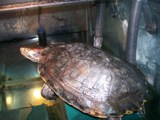 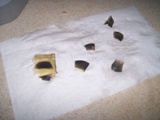
|
Tina Turtle's Shell Rot -- 3/8/11
Hi,
<Hiya - Darrel here>
I have a probably 20 year old Painted Turtle that resides in a custom
made tank on my kitchen counter, just to let you know how much a part
of things she is.
<I bet she likes it. Turtles seem to be fascinated with what they
see in the world beyond them>
She has two light sources. The clip on lights have different bulbs. One
a full spectrum fluorescent the other a heat lamp. She doesn't like
the fluorescent and goes under her platform so I don't think she is
getting enough D and calcium to support her shell.
<"Full Spectrum" is a wide open definition, Debbie. What
we're looking for specifically is UV/B. If she doesn't like the
bulb you have, check out Zoo-Med's line of Repti-Sun bulbs.>
She has not been eating for about two months, I am assuming, like she
would do if she were hibernating. She has somewhat done this in the
past but this year it is more obvious.
<Has anything changed in her habitat -- or NEAR her habitat? I had a
box turtle once that was completely off her feed when we installed a
new, bigger pool pump. The vibration was completely different than the
old pump, she couldn't get away from it so she started showing
signs of stress. Just a thought - look for things like that>
Two years ago she developed shell rot on two of her upper flukes
'¦
<you probably mean scutes? The octagonal-shaped shell
plates?>
'¦ when they came off prematurely to her normal molting, if
that is what you call it when she sheds her shell. The vet told me to
put Iodine on the spots and let her dry out periodically. It seemed to
work. She now has air bubbles under those two flukes. What should I
do?
<I'm going to enclose a treatment article that describes how to
'dry out' and isolate a turtle. Keeping her warm and DRY for 4
or 5 weeks will help her fight off any shell problems she may be having
(the iodine & anti fungals described couldn't hurt, either>
And could the water quality be the problem. I feed her out of the tank
and wait until she poops before returning her to the tank so it stays
relatively clean. But if she doesn't eat she doesn't poop and
the tank doesn't appear dirty and it doesn't get cleaned as
much. A little algae is starting to show up now and I intend to empty
the whole tank and start over as a spring cleaning.
<You could sure use her "dry docking" as a time to break
down and completely clean her tank. Wash, rinse, bleach...
everything.>
<MEANWHILE '¦ being in a new world may be a bit stressful
for her, but having ONLY a few minutes each day to drink, poop and eat
has been known to stimulate appetites.>
My main question again, what should I do about the air bubbled
flukes?
<While she's out, treat her for fungus (as described in the
article) and if you see no improvement in two weeks '¦ a
trip to the vet is in order>
Thanks for your help,
Tina's Caregiver Deb
<Yer welcome! Tell Tina we said 'hi'>
|
Musk turtle shell
2/25/11
Hey
<Hiya! Darrel here>
I have 2 Common Musk Turtles which are just over 2 years old.
I'm pretty sure one is male and the other is female (but
I'm not positive). The carapaces are around 3-4 inches long
now. They are fed every other day.
<About right>
Their diet consists of ReptoMin turtle sticks and frozen brine
shrimp/turtle food/crayfish alternately. They also get 4 drops of
Beaphar Turtle Vit every day (as per the
Instructions of the place I bought them and the packaging). They
are fed in the water because they like to bite (especially the
male!).
<Yes they do! Mud and Musk turtles tend to have short
tempers>
They have recently moved into a new home: a 240 liter fish tank
kept about a third filled. I am using the canister filter that
came with it so it is definitely more than good enough to keep
the water clean. There is a reptile UVB bulb (one of the ones
that goes in the lid of the tank) and a ceramic heat lamp
centered on the platform for basking. The light is kept on all
day from about 7am to 10pm.
<Maybe just a tiny bit long. They wouldn't encounter that
it the wild>
They have lots of dark places to hide but also have a platform
and plenty of things they can climb on to bask on. I rarely see
them basking though but I gather from some research that this is
about right for musk turtles.
<They DO bask, not as often as other turtles -- and
they're more likely to do it is secret - retreating to the
water at the first movement or vibration - so even though people
don't SEE them basking, the UV and the heat lamps are still
important.>
The water is 78 degrees (measured with a thermometer) and is kept
at this temperature with a heater.
<Too warm. They'd never find 78 degree water in nature
unless they were vacationing in Hawaii. Water should be 68-73
degrees, in other words "Room Temperature" and them
they have a CHOICE between cool water and warm basking>
I do a part water change every 2 weeks and give the tank and
filter a good clean about once a month. They are not next to a
window.
<Other than the temp - everything sounds GREAT. Remove the
heater completely and let the water be room temp.>
So the problem is with their shells. Over the last couple of days
they have developed what looks to me like a white/grey deposit
(?)/coat on their shells but the shells are still hard. I've
attached some pictures but they're not that clear because the
turtles wouldn't be helpful and sit still (one has some glare
on it from the light too)! I'm worried that it's shell
rot but I read a few posts on the website and saw one about
mineral deposits and now wonder if this could be the case but as
I couldn't find any pictures I would be really grateful if
you could tell me what you think. I live in quite a hard water
area and there is almost constantly a mineral deposit mark around
the tank so I think it is probably mineral deposits on the
shells. However it has appeared in literally the last couple of
days which has concerned me. They are eating fine and being as
curious/nosy as ever so they don't seem to be suffering any
ill effects at the minute. Sorry for the essay but it says to
include as much information as possible! Thanks in advance!
Kim
<Kim - looks like water spots/mineral buildup to me. Scrape a
small section gently with something hard. Fungus will usually
come off as a sheet or flakes, where mineral deposits just
disintegrate (or don't come off at all). Try washing a spot
with a bit of vinegar.>
<If they stay healthy and active and the shell doesn't
soften or start to smell, then just wash the minerals away a
little bit with vinegar every tank cleaning and put it out of
your mind>
|
|
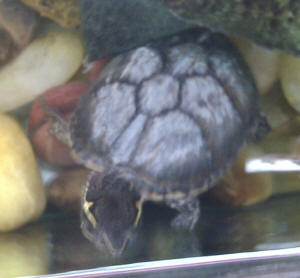
|
|
Turtle shell 2/11/11
Hello, My name is Jesy
<Hiya Jesy - Darrel here>
I own a small red eared slider which has been in my care for a
while now, I have nursed him back to health from severe sickness.
I have just today rescued another one, just under a year from an
owner who was treating it very badly and neglecting to take care
of it. It has white clusters over a large part of its shell that
do not seem moist in any way, they look more like pigment change.
I was wondering it this is simply calcium deficiency, a fungus
infection, or shell rot. I will take him to the vet but the other
turtle cost me a lot to take to the vet and I'm hoping I can
do something about this at home. I've attached some pictures,
thank you!
<Yer welcome>
<What I see in the pictures is, for lack of a better word,
stains. I could be from some combination of lack of proper UV-B
light, lack of calcium and/or unclean water, the scute material
is stained, faded, washed
out, etc. This is not uncommon in Emydid turtles such as sliders,
cooters, etc. and has no negative effect on their health as long
as the conditions I mentioned are no longer present.>
<In other words, clean up the environment, follow the rules
(read link below) and don't worry>
< http://www.wetwebmedia.com/FWSubWebIndex/RESCareBarton.htm
>
|
|
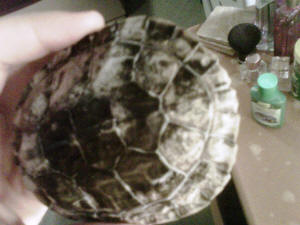
|
peeling turtle, RES 1/30/11
Hi guys,
<Hiya - Darrel here>
I think you have a great site!
<Thank you, Stephanie! We think so too, but it's nice to be
noticed.>
-- And I like how we can ask additional questions that we think that
you have not answered or not answered to the full content.
<That's what I'm here for>
I have one red slider turtle living in a 40 gallon tank. We just moved
him out of a 10 gallon not properly lit tank.
<Progress is good. UV-B lighting is even better!>
But his shell is peeling off it really big pieces. We recently just
found a 1 inch by 1in piece of his shell in the tank. And while looking
at his shell it has a metallic look and more big chunks are coming off.
Is this normal?
<That depends. When you say his shell is coming off, do you mean the
individual scutes are coming off in thin, almost transparent pieces?
THAT is normal, health growth. As the shell grows the individual plates
slough off the top layer in favor of a new, slightly bigger scute
underneath. The key here is that the pieces are generally shaped like
the scutes and they are thin, almost transparent -- and yes, they can
have a slight metallic look to them.>
<If this is what you're seeing, it's normal growth
'¦ probably a sudden spurt due to the cleaner water and
healthier conditions. If it's actual chunks of the shell itself,
leaving a white bone-looking layer underneath '¦ that is a
serious health concern that requires a Veterinary visit and a physical
examination.>
-- and if not what can we do to stop it or help it.
<If the latter is the case, keep him warm and dry during the course
of treatment given by the Vet>
Thank you so much. I really want the best for my turtle.
Thank you.
<Yer welcome!>
|
Female Red Ear Slider Turtle, lack of data
1/13/11
Hi! So there is something wrong with my turtles shell she is an
Adult Red Ear Slider, I got her a couple months ago from a friend
and this white stuff just showed up within the last couple week
or two... I have done a ton of research using your site and it
seems as though it could be mild shell rot, fungus, or even
possible hard water build up...
<Yes>
But I don't know. If you could please shed some light on this
issue that would be great! I have attached some photos to help
explain. Thank you so much!!
<Please (re)read here:
http://wetwebmedia.com/FWSubWebIndex/turtshellrot.htm
and the linked files above. Bob Fenner>
|
|
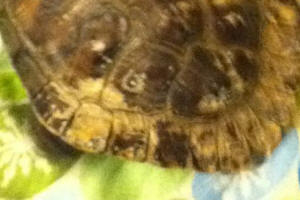 
|
|
|

